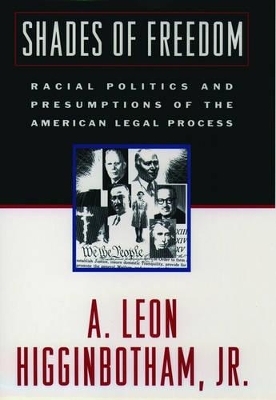
Shades of Freedom
Racial Politics and Presumptions of the American Legal Process
Seiten
1997
Oxford University Press Inc (Verlag)
978-0-19-503822-4 (ISBN)
Oxford University Press Inc (Verlag)
978-0-19-503822-4 (ISBN)
Few individuals have had as great an impact on the law, both its practice and its history, as A. Leon Higginbotham, Jr. A winner of the Presidential Medal of Freedom, the nation's highest civilian honour, he has distinguished himself over the decades both as a professor at Yale, the University of Pennsylvania, and Harvard, and as a judge on the United States Court of Appeals. But Judge Higginbotham is perhaps best known as an authority on racism in America: not the least important achievement of his long career has been In the Matter of Color, the first volume in a monumental history of race and the American legal process. Published in 1978, this brilliant book has been hailed as the definitive account of racism, slavery, and the law in colonial America.
Now, after twenty years, comes the long-awaited sequel. In Shades of Freedom, Higginbotham provides a magisterial account of the interaction between the law and racial oppression in America from colonial times to the present, demonstrating how the one agent that should have guaranteed equal treatment before the law, the judicial system, instead played a dominant role in enforcing the inferior position of blacks. The issue of racial inferiority is central to this volume, as Higginbotham documents how early white perceptions of black inferiority slowly became codified into law. Perhaps the most powerful and insightful writing centres on a pair of famous Supreme Court cases, which Higginbotham uses to portray race relations at two vital moments in our history. The Dred Scott decision of 1857 declared that a slave who had escaped to free territory must be returned to his slave owner. Chief Justice Roger Taney, in his notorious opinion for the majority, stated that blacks were "so inferior that they had no right which the white man was bound to respect". For Higginbotham, Taney's decision reflects the extreme state that race relations had reached just before the Civil War. And after the War and Reconstruction, Higginbotham reveals, the Courts showed a pervasive reluctance (if not hostility) toward the goal of full and equal justice for African Americans, and this was particularly true of the Supreme Court. And in the Plessy v. Ferguson decision, which Higginbotham terms "one of the most catastrophic racial decisions ever rendered," the Court held that full equality - in schooling or housing, for instance - was unnecessary as long as there were "separate but equal" facilities. Higginbotham also documents the eloquent voices that opposed the openly racist workings of the judicial system, from Reconstruction Congressman John R. Lynch to Supreme Court Justice John Marshall Harlan to W. E. B. DuBois, and he shows that, ironically, it was the conservative Supreme Court of the 1930s that began the attack on school segregation and overturned the convictions of African Americans in the famous Scottsboro case. But today racial bias still dominates the nation, Higginbotham concludes, as he shows how in six recent court cases the public perception of black inferiority continues to persist.
In Shades of Freedom, a noted scholar and celebrated jurist offers a work of magnificent scope, insight, and passion. Ranging from the earliest colonial times to the present, it is a superb work of history, and a mirror to the American soul.
Now, after twenty years, comes the long-awaited sequel. In Shades of Freedom, Higginbotham provides a magisterial account of the interaction between the law and racial oppression in America from colonial times to the present, demonstrating how the one agent that should have guaranteed equal treatment before the law, the judicial system, instead played a dominant role in enforcing the inferior position of blacks. The issue of racial inferiority is central to this volume, as Higginbotham documents how early white perceptions of black inferiority slowly became codified into law. Perhaps the most powerful and insightful writing centres on a pair of famous Supreme Court cases, which Higginbotham uses to portray race relations at two vital moments in our history. The Dred Scott decision of 1857 declared that a slave who had escaped to free territory must be returned to his slave owner. Chief Justice Roger Taney, in his notorious opinion for the majority, stated that blacks were "so inferior that they had no right which the white man was bound to respect". For Higginbotham, Taney's decision reflects the extreme state that race relations had reached just before the Civil War. And after the War and Reconstruction, Higginbotham reveals, the Courts showed a pervasive reluctance (if not hostility) toward the goal of full and equal justice for African Americans, and this was particularly true of the Supreme Court. And in the Plessy v. Ferguson decision, which Higginbotham terms "one of the most catastrophic racial decisions ever rendered," the Court held that full equality - in schooling or housing, for instance - was unnecessary as long as there were "separate but equal" facilities. Higginbotham also documents the eloquent voices that opposed the openly racist workings of the judicial system, from Reconstruction Congressman John R. Lynch to Supreme Court Justice John Marshall Harlan to W. E. B. DuBois, and he shows that, ironically, it was the conservative Supreme Court of the 1930s that began the attack on school segregation and overturned the convictions of African Americans in the famous Scottsboro case. But today racial bias still dominates the nation, Higginbotham concludes, as he shows how in six recent court cases the public perception of black inferiority continues to persist.
In Shades of Freedom, a noted scholar and celebrated jurist offers a work of magnificent scope, insight, and passion. Ranging from the earliest colonial times to the present, it is a superb work of history, and a mirror to the American soul.
A. Leon Higginbotham, Jr. is Public Service Professor of Jurisprudence at the Kennedy School of Government, Harvard University. He was formerly Chief Judge on the United States Court of Appeals for the Third Circuit. He has taught at Yale and at the Harvard, New York University, and University of Pennsylvania Law Schools, and is a recipient of the Presidential Medal of Freedom. His landmark volume In the Matter of Color won the American Bar Association's Silver Gavel Award and the National Bar Association's Literary Award.
| Erscheint lt. Verlag | 13.3.1997 |
|---|---|
| Zusatzinfo | 16 pp plates |
| Verlagsort | New York |
| Sprache | englisch |
| Maße | 241 x 162 mm |
| Gewicht | 694 g |
| Themenwelt | Recht / Steuern ► Arbeits- / Sozialrecht ► Sozialrecht |
| Recht / Steuern ► EU / Internationales Recht | |
| Recht / Steuern ► Öffentliches Recht ► Besonderes Verwaltungsrecht | |
| Sozialwissenschaften ► Politik / Verwaltung | |
| Sozialwissenschaften ► Soziologie | |
| ISBN-10 | 0-19-503822-3 / 0195038223 |
| ISBN-13 | 978-0-19-503822-4 / 9780195038224 |
| Zustand | Neuware |
| Haben Sie eine Frage zum Produkt? |
Mehr entdecken
aus dem Bereich
aus dem Bereich
meine Rechte: Wohnen, Arbeiten, Steuern, Mobilität
Buch | Softcover (2024)
C.H.Beck (Verlag)
CHF 16,65
Textausgabe mit ausführlichem Sachverzeichnis
Buch | Softcover (2024)
dtv Verlagsgesellschaft
CHF 29,25
Buch | Softcover (2024)
dtv Verlagsgesellschaft
CHF 27,85


